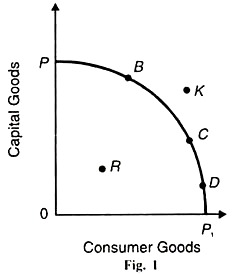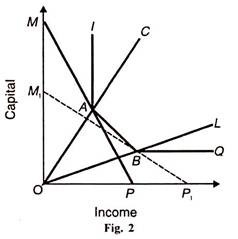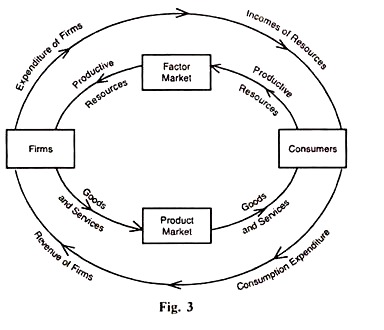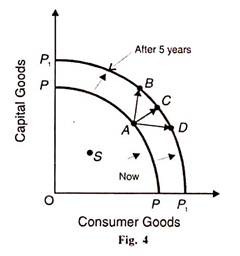The following points highlight the five major problems of resource allocation in an economy. The problems are: 1. What and How Much to Produce 2. How to Produce 3. To Determine Income Distribution 4. To Utilise Resources Fully 5. To Provide an Incentive to Growth.
Resource Allocation: Problem # 1.
What and How Much to Produce:
The first function of prices is to resolve the problem of what to produce and in what quantities. This involves allocation of scarce resources in relation to the composition of total output in the economy.
Since resources are scarce, the society has to decide about the goods to be produced:
ADVERTISEMENTS:
Wheat, cloth, roads, television, power, buildings, and so on. Once the nature of goods to be produced is decided, then their quantities are to be decided.
How many kilos of wheat, how many million metres of cloth, how many kilometers of roads, how many televisions, how many million kw of power, how many buildings, etc. Since the resources of the economy are scarce, the problem of the nature of goods and their quantities has to be decided on the basis of priorities or preferences of the society.
If the society gives priority to the production of more consumer goods now, it will have less in the future. A higher priority on capital goods implies less consumer goods now and more in the future. This problem can be explained with the help of the production possibility curve, as shown in Figure 1.
Suppose the economy produces capital goods and consumer goods. In deciding the total output of the economy, the society has to choose that combination of capital and consumer goods which is in keeping with its resources. It cannot choose the combination R which is inside the production possibility curve PP because it reflects economic inefficiency of the system in the form of unemployment of resources.
ADVERTISEMENTS:
Nor can it choose the combination К which is outside the current production possibilities of the society; the society lacks the resources to produce this combination of capital and consumer goods. It will have, therefore, to choose among the combinations В, C, or D which give the highest level of satisfaction.
If the society decides to have more capital goods, it will choose combination В; and if it wants more consumer goods, it will choose combination D.
As a matter of fact, consumers have to pick and choose from the vast variety of goods offered to them. The urgency of desire for certain goods means that the consumers are prepared to pay a large sum of money and higher prices. It implies larger profits for producers producing these commodities. If consumers desire goods less urgently, it shows their reluctance to spend more on them and they offer lower prices.
ADVERTISEMENTS:
Expecting shrinkage in profits, producers also bring smaller quantities of their products in the market. If producers increase the supply of a commodity without any regard to the wishes of consumers, it will have a low value in their estimation and the lower will be its price.
A small supply, on the other hand, increases the prestige of the commodity in the minds of consumers and they pay a higher price for it. Thus, the different prices which consumers pay for various commodities and services reflect their comparative values to them Prices also change with consumers’ tastes and preferences.
Consumers register their preferences towards commodities by paying more for them and their distaste by offering less. If consumers show preference for auto-rickshaws and taxis in place of cycle-rickshaws and tongas, they offer lower prices for the latter.
Some of the persons engaged in the latter trades will seek other occupations or may even start plying auto-rickshaws and taxis or open workshops if they have the requisite means. Thus consumers’ tastes and preferences are also reflected in the prices of goods and services.
Generally, a change in the price of a commodity acts simultaneously as a beacon light and a warning signal for the producer or the consumer as the case may be. If the price of a commodity rises, it warns the consumers to buy less of it and at the same time it beckons the producer to produce more of it. High price and prospects of larger profits attract new producers into the industry in the long-run.
Resource owners also shift their resources to this high priced industry. Thus when all firms in the industry produce more, supply increases more than the demand and the price may tend to fall. On the other hand, the withdrawal of resources from the low-priced commodity brings a fall in its output.
But the shifting of consumer-demand towards it tends to raise its price in the long-run. This tendency continues till both the commodities are equally priced and offer the same profits to producers in the two industries.
Contrariwise, if the price of a commodity falls, it is a warning to the producers to produce less and an invitation to the consumers to buy a larger quantity of it. Low price and the consequent low profits will induce producers to shift resources away from this industry to the high-priced industry. This long-run tendency will reduce supply whereas the demand is on the increase.
Consequently, price tends to rise. On the other hand, supply increases in the high-priced industry as a result of shifting of resources into it. Demand being less, price tends to fall. This long-run tendency continues till the two commodities are so priced as to bring in equal profits to producers in both industries.
ADVERTISEMENTS:
Thus the consumer is the sovereign. He sets the price and producers manufacture those commodities which he wants more. The more the producers produce, the larger the profits they earn and so do the resource owners. The fate of the producer is sealed if the consumer has no liking for his product and sets a low price. The producer, therefore, at once reacts when the consumer acts and resource allocation takes place along with the production of goods.
Resource Allocation: Problem # 2.
How to Produce:
The next task of prices is to determine the techniques to be used for the production of articles. Prices of factor services are the rewards received by them. Wage is the price for the service of labour, rent is the price for the service of land, interest for the service of capital and profit for the service of entrepreneur.
Thus wages, rent, interest and profit are the prices paid by the entrepreneur for the services of the factors of production which make up the costs of production.
ADVERTISEMENTS:
Every producer aims at using the most efficient productive process. An economically efficient production process is one which produces goods with the minimum of costs. The choice of a production process will depend upon the relative prices of the factor services and the quantity of goods to be produced.
A producer uses expensive factor services in smaller quantities relative to cheap resources. In order to reduce costs of production he substitutes cheaper resources for the dearer. If capital is relatively cheaper than labour, the producer will use a capital-intensive production process. Contrariwise, if labour is relatively cheaper than capital, labor-intensive production processes will be used.
In underdeveloped countries where labour is relatively cheap, techniques involving more labour contribute to least costs; while in developed economies where labour is relatively expensive, capital-using and labour-saving techniques combine efficiency with minimum costs.
Since one price for a single commodity prevails in a free enterprise economy, only economically efficient producers can continue in the industry. Those incapable of paying resources their minimum rewards (prices) will either close down or shift to the manufacture of some other commodity.
ADVERTISEMENTS:
The technique to be .used for the production of goods is explained in terms of Figure 2. Suppose there are only two techniques of production in an economy that is capital-intensive shown by the ray ОС and labour-intensive shown by the ray OL. IABQ is the isoquant showing a unit-output level by using either of the techniques.
Point A represents a unit output level produced with the capital-intensive technique and point В the same output level produced with the labour-intensive technique.
MP and M1P1 are the iso-cost or cost-outlay lines which reflect the market prices of capital and labour. The line MP shows that capital is cheap relative to labour and the optimal production will be at point A with the capital-intensive technique. On the other hand, if labour is cheap relative to capital, as shown by the line M1P1, the optimal production will be at point В with the labour-intensive technique.
The technique to be used also depends upon the type and quantity of goods to be produced: For producing capital goods and large outputs, complicated and expensive machines and techniques are required. On the other hand, simple consumer goods and small outputs require small and less expensive machines and comparatively simple techniques.
Further, it has to be decided what goods and services are to be produced in the public sector and what goods and services in the private sector.
Resource Allocation: Problem # 3.
ADVERTISEMENTS:
To Determine Income Distribution:
Another function of prices is to determine the distribution of income. In a free enterprise economy product- distribution and income-distribution are interdependent. It is a system of mutual exchanges where the producers and consumers are largely the same people.
The owners of factors sell their services for money and then spend that money to buy the goods produced by factor services. Producers sell goods and services to consumers for money and consumers receive incomes as owners of factor services. Thus income flows from owners of resources (consumers) to producers and back to consumers again. Such a circular flow of income is shown in Figure 3.
Prices play an important role in this income flow. When the consumers buy commodities, it is their cost of living. When producers sell commodities, it is their business receipts. What consumers receive as owners of factor-services, it is their personal income and when producers pay for factor-services, it is the cost of production.
It follows that the income of an individual depends upon the amount of resources owned by him and the evaluation of his resources in the minds of consumers. People owning large quantities of resources have high incomes and/or they contribute more to the making of commodities which satisfy the consumers much.
ADVERTISEMENTS:
Contrariwise, people owning small quantities of resources have low incomes and/or they contribute little to the making of commodities which add to consumer satisfaction. Such income differentials are, however, self-correcting. No individual can afford to receive a low income for long. So workers in the low-income category will seek employment in that industry which pays higher wages.
This movement of workers from the lower-paying industry to the higher-paying industry results in the diminution of the supply of the former industry and increase in the supply of the latter industry. Reduction in supply raises the price of the product, increases the profits of the producer and the incomes of the workers.
On the other hand, increase in the supply of the other commodity lowers its price, reduces profits as well as the incomes of the workers. This process will continue till income differentials disappear altogether. Thus prices not only determine income distribution but also bring its equality.
Resource Allocation: Problem # 4.
To Utilise Resources Fully:
The price mechanism also helps in the full utilisation of the resources of an economy. Full utilisation of resources implies their full employment. This requires increase in income through large investments, and ultimately to the equality of saving and investment.
In a growing economy equality between saving and investment is brought about by reductions in interest rates. When the economy is nearing the level of full employment by an efficient use of resources, income grows at a rapid rate and so do savings. But investment lags behind which can be raised to the level of savings by interest-rate reductions. Thus the rate of interest acts as an equilibrating mechanism.
ADVERTISEMENTS:
However, the rate of interest cannot be relied upon exclusively for this purpose in an economy nearing full employment. Therefore, monetary and fiscal measures, and physical controls are also required to influence the decisions of consumers and producers regarding saving and investment.
Resource Allocation: Problem # 5.
To Provide an Incentive to Growth:
Lastly, prices are an important factor in providing for economic growth. The impetus for improvement, innovation and development comes through the price mechanism. Higher prices and profits encourage large industrial concerns to spend huge sums on research and experimentation to improve and develop better techniques.
The adaptation of the economic system to change in wants, resources and technologies takes place through prices. If consumers want more of one commodity in preference to the other the price of the former rises. Resources move to that industry. Profits also increase.
Larger profits lead to the adoption of superior technology which lowers costs. Larger profits and low costs attract new producers who provide new capital. All this leads to capital formation. No doubt economic growth depends upon a number of other factors, yet prices play an important role in providing for economic growth with stability.
This is explained in terms of Figure 4 where the economy is shown to be stagnant at point S inside the production possibility curve PP. For its economic growth, it has to be moved on to point A of the production possibility curve PP whereby the economy produces larger quantities of consumer and capital goods.
ADVERTISEMENTS:
This is possible through a higher rate of capital formation which consists of replacing existing capital goods with new and more productive ones by adopting more efficient production techniques or through innovations.
More growth leads to the outward shifting of the production possibility curve from PP to P1 P1. The economy moves, say after 5 years, from point A to В or С or D on the P1P1 curve. Point С represents this situation where larger quantities of both consumer and capital goods are produced in the economy. Economic growth enables the economy to have more of both the goods through higher prices, profits and incomes.
Conclusion:
Thus the price mechanism, working through supply and demand in a free enterprise economy acts as the principal organising force. It determines what to produce and how much to produce. It determines the rewards of the factor services.
It brings about an equitable distribution of income by causing resources to be allocated in right directions. It works to ration out the existing supplies of goods and services, utilizes the economy’s resources fully and provides the means for economic growth.



